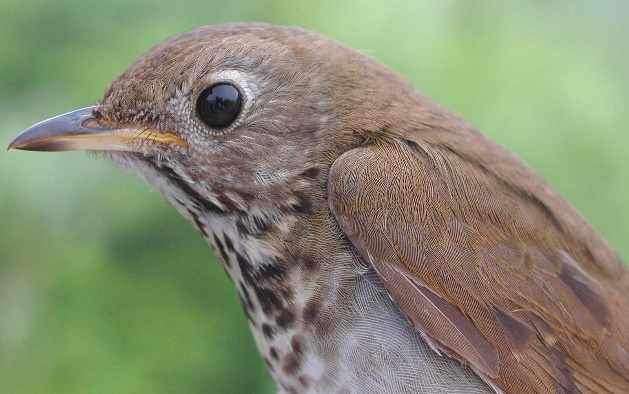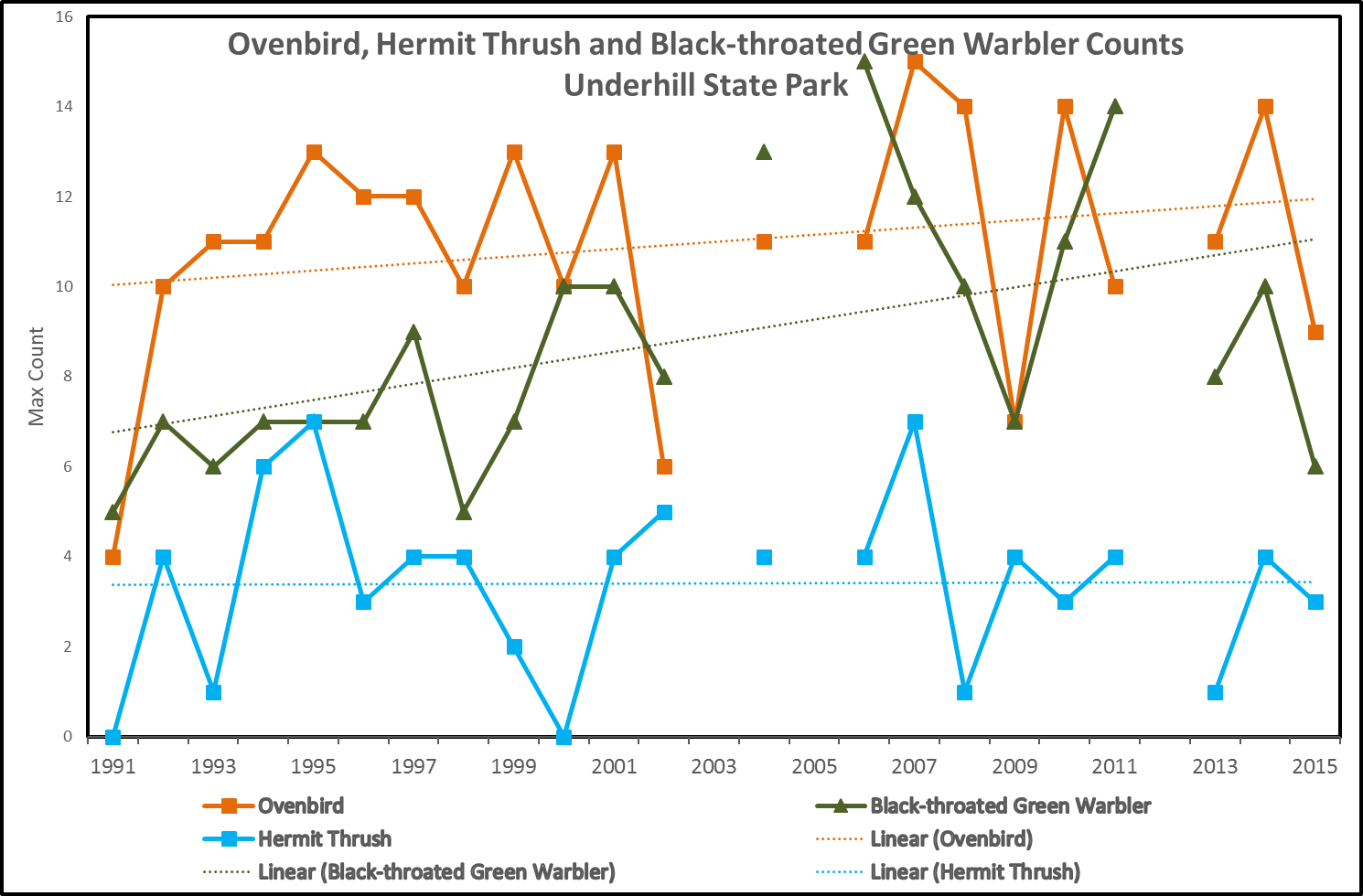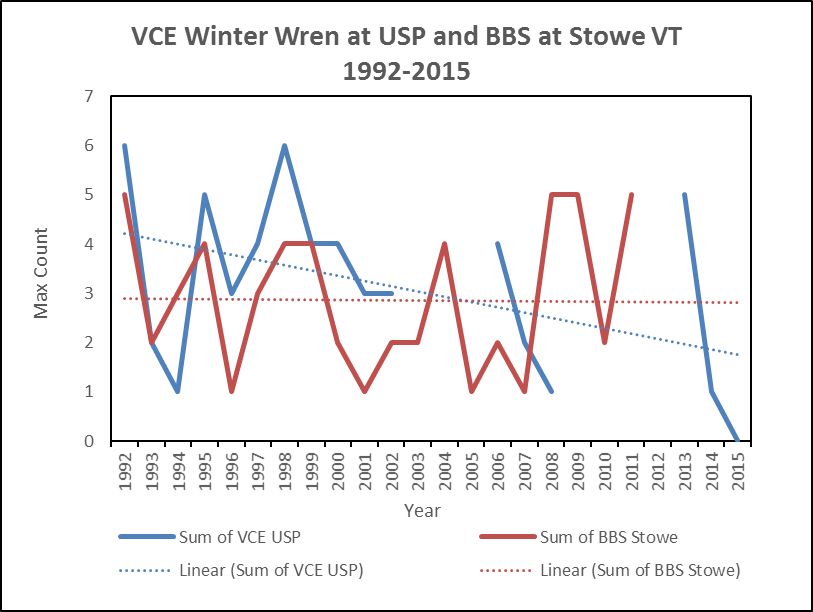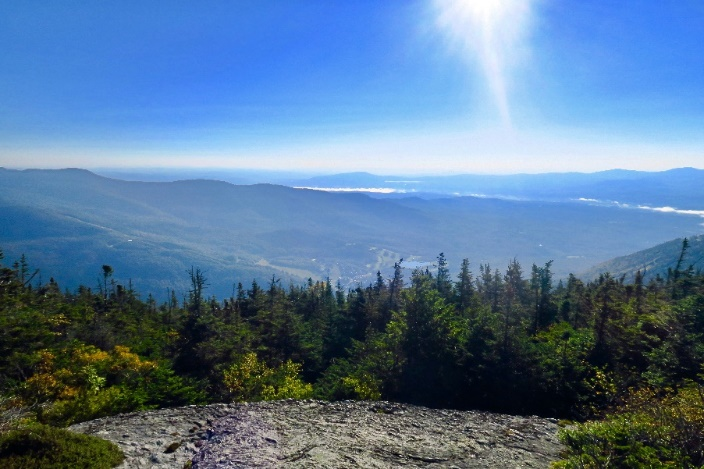Forest Birds
Breeding Bird Surveys

Bicknell’s Thrush is one of several mid- and high-elevation songbird species from New England that migrates long distances to overwinter. The factors that affect neotropical migrant bird survivorship are many: demographics, inter-species competition, parental survival, migratory route conditions, etc. (eNature, 2007; Faaborg et al., 2010). But land use changes in breeding grounds and overwintering areas clearly affect migratory species, and in the case of the Bicknell’s Thrush may be reducing its already limited habitat (Rimmer et al., 2005; VNRC, 2007). Only limited habitat is present in Massachusetts, where the Bicknell’s thrush occurred prior to 1972 but is no longer found (Atwood et al., 1996). While estimates of deforestation in some of the species’ non-breeding grounds, such as Haiti, may vary, loss of forested habitat remains a serious threat (Alvarez-Berríos et al., 2013).
Migratory passerines are subject to many human-induced and abiotic perturbations on their breeding areas and overwintering grounds. Hurricanes can have diverse effects on bird populations, from mass mortality of individual birds to the loss of trees for cavity-nesting birds to the creation of new and beneficial habitat (Brooks and Stouffer, 2010; Newton, 2007; Yaukey, 2008). Hurricanes can affect refueling locations on the migratory routes (Barrow et al., 2005), though there is evidence that some migratory birds are plastic enough in their behavior to avoid some of the worst effects of storms and hurricanes (Boone, 2016; eNature, 2007). Nonetheless, Bicknell’s thrush and other migratory passerines are vulnerable to habitat loss anywhere along their migratory routes.
Regular monitoring is essential to assess trends in species presence, species richness, population levels, and demographics. Such information is critical to the conservation of sensitive species.
The Data
Breeding Bird Surveys were conducted at permanent study sites located in Underhill State Park (USP). This site is part of Vermont Center for Ecostudies (VCE) long-term Forest Bird Monitoring Program (FBMP) which was initiated in 1989 with the primary goals of conducting habitat-specific monitoring of forest interior breeding bird populations in Vermont and tracking long-term changes (Faccio et al., 1998).
The study site contains five point count stations. Survey methods include unlimited distance point counts, based on the approach described by Blondel et al. (1981) and used in Ontario (Welsh, 1995). Counts begin shortly after dawn on days where weather conditions are unlikely to reduce count numbers. Observers record all birds seen and heard during a 10-min sampling period, divided into 2-, 3-, and 5-minute intervals. The hardwood-dominated site at Underhill was sampled twice during the breeding season.
2015 in Summary
Funding shortfalls prevented bird surveys on Mount Mansfield and in the Lye Brook Wilderness in 2015, but VCE provided data collected through their Underhill State Park survey.

The number of individual birds detected at Underhill State Park was just above average. Species richness at Underhill State Park in 2014 was the second lowest ever recorded but in 2015 it was slightly higher, moving up from 14 to 15 species.
A total of at least 57 avian species have been detected during breeding bird surveys at three study sites on Mt. Mansfield from 1991-2015. Surveys from the mid-elevation, northern hardwood study sites at Underhill State Park had a species composition of 51 species over this time span.
Long Term Trends
The total number of individuals and species richness are low for at Underhill State Park, with 50 individuals of 15 species recorded. The Barred Owl, a new record for 2014, was not seen in 2015. The five most common species at Underhill State Park are Black-throated green and Black-throated Blue Warblers, Ovenbirds, Red-eyed Vireos and Hermit Thrushes. These five species were the most common in 2014, too. Overall, long term trends based on counts of Ovenbird and Black-throated Green Warbler still appear to be increasing, while the long-term trend for Hermit Thrush, the Vermont State bird, remained relatively flat (Figure 21). As with the Mt. Mansfield montane sites, Winter Wren numbers dropped in 2015, too, with none detected this year in Underhill (Figure 22). Data from another local site (Stowe, VT) shows a flat but not declining trend for Winter Wrens (Figure 22). Please note that the trends may be affected by data gaps during the time period covered.

Implications
VCE has observed, based on their 25-year dataset, that many of the high-elevation bird species that they have been monitoring on and around Mt. Mansfield are declining. This includes Bicknell’s Thrush, Blackpoll Warbler, Dark-eyed Junco and White-throated Sparrow. Interpretation of these trends must take into account the variability in point count survey results, from fluctuations in abundance, detection rates, nesting stage and other biotic factors. An additional caveat is that this set of data comes from a limited geographic area. Nonetheless, other similar surveys from this region show declines in songbird populations, particularly among those species engaged in long-distance migration (McNulty et al., 2008; Eddy, 2008).
Many anthropogenic stressors may be contributing to these declines (e.g., habitat degradation, land use change due to development, acidic precipitation and other atmospheric pollutants, or changing climatic conditions). Bicknell’s Thrush is one species that is also being heavily impacted on its overwintering grounds due to forests under siege from illegal charcoal production, subsistence farming, logging and squatting (e.g., McFarland et al., 2013; Rimmer and McFarland, 2013). Loss of winter habitat is of crucial concern because of the birds’ restricted range and highly selective habitat requirements, but loss of habitat and resources anywhere along the migratory route can have an adverse effect (Boone, 2016).
There are efforts being made to compile bird data from multiple sources, such as the Avian Knowledge Network (U.S. NABCI, 2007). Comparison of surveys from ecologically comparable areas may help obviate the variability found from single geographic sources, and help ascertain the extent and consistency of the decline. By comparing different locations, it may be possible to identify or eliminate some sources of variation.
The role of climate change in the frequency and severity of tropical storms and hurricanes has not been clearly determined, but climate change in terms of rising temperatures alone will add an additional abiotic stressor. In the meantime, forest birds will likely need to rely on their innate abilities to adapt to changing conditions and environments to survive and continue to thrive. This will be more difficult for habitat specialists such as Bicknell’s Thrush.

Neo-tropical migratory birds are vulnerable to biotic and abiotic changes and stressors all along their routes. It remains to be seen whether they are adaptable enough in behavior to surmount the increasing tide of change.
References
- Alvarez-Berríos, N.L., D.J. Redo, T.M. Aide, M.L. Clark and R. Grau. 2013. Land Change in the Greater Antilles between 2001 and 2010. Land, 2 (2) (2013), pp. 81–107.
- Atwood, J. L., C. C. Rimmer, K. P. McFarland, S. H. Tsai, and L. R. Nagy. 1996. Distribution of Bicknell's Thrush in New England and New York. Wilson Bulletin 108:650–661.
- Barrow, W. J., J. J. Buler, R. H. Diehl, S. Faulkner, F. R. Moore, and L. Randall (2005). Broadscale Response of Landbird Migration to the Immediate Effects of Hurricane Katrina. In Science and the Storms: The USGS Response to the Hurrcanes of 2005 (G. . Farris, G. . Smith, M. . Crane, C. . Demas, L. . Robbins and D. . Lavoie, Editors). USGS, pp. 131–136.
- Blondel, J., C. Ferry, and B. Frochot. 1981. Point counts with unlimited distance. Pp. 414-420, In C. John Ralph and J. Michael Scott (Eds.). Estimating numbers of terrestrial birds. Studies in Avian Biology 6: 630pp.
- Boone, M. 2016. The effect of Hurricane Sandy on landbird migration in the northeastern United States. Diss. University of Delaware, 2016.
- Brooks, M.E., and P.C. Stouffer. 2010. Effects of Hurricane Katrina and salvage logging on Bachman's Sparrow." The Condor 112.4 (2010): 744-753.
- Eddy, G. and Emrick, J. 2008. Bird Population Declines in the Central Appalachian Mountains of West Virginia. The Redstart 75(2):48-98. http://www.brooksbirdclub.org/uploads/5/2/8/3/52832773/2008_redstart_vol_75-2.pdf
- eNature. Nature Watch: Hurricanes and Birds. 2007. http://www.enature.com/articles/detail.asp?storyID=580
- Faaborg, J., Holmes, R. T., Anders, A. D., Bildstein, K. L., Dugger, K. M., Gauthreaux, S. A., Heglund, P., Hobson, K. A., Jahn, A. E., Johnson, D. H., Latta, S. C., Levey, D. J., Marra, P. P., Merkord, C. L., Nol, E., Rothstein, S. I., Sherry, T. W., Sillett, T. S., Thompson, F. R. and Warnock, N. (2010), Conserving migratory land birds in the New World: Do we know enough?. Ecological Applications, 20: 398–418. doi:10.1890/09-0397.1
- Faccio, S.D., C.C. Rimmer, and K.P. McFarland. 1998. Results of the Vermont Forest Bird Monitoring Program, 1989-1996. Northeastern Naturalist 5(4): 293-312.
- McFarland K.P., C.C. Rimmer, J.E. Goetz, Y. Aubry, J.M. Wunderle, Jr., A. Sutton, J.M. Townsend, A. Llanes Sosa, and A. Kirkconnell. 2013. A winter distribution model for Bicknell’s Thrush (Catharus bicknelli), a conservation tool for a threatened migratory songbird. PLoS ONE 8(1): e53986. DOI:10.1371/journal.pone.0053986.
- McNulty, S.A., S. Droege, R.D. Masters. 2008. Longterm trends in breeding birds in an old-growth Adirondack forest and the surrounding region. Wilson Journal of Ornithology 120:153–158.
- Newton, I. (2007). Weather-related mass-mortality events in migrants. Ibis 149:453–467. doi: 10.1111/j.1474-919X.2007.00704.x
- Rimmer, C.C. and K.P. McFarland. 2013. Bicknell's Thrush: a twenty-year retrospective on the Northeast's most vulnerable songbird. Bird Observer 41:9-16.
- Rimmer, Christopher C., J.M. Townsend, A.K. Townsend, E.M. Fernández and J. Almonte. 2005. Avian diversity, abundance, and conservation status in the Macaya Biosphere Reserve of Haiti. Ornitología Neotropical 16 (2005): 219-230.
- Vermont Natural Resource Council, 2007. Roundtable on Parcelization and Forest Fragmentation – Final Report. Primary Author: Jamey Fidel, Forest and Biodiversity Program Director, Vermont Natural Resources Council.
- U.S. North American Bird Conservation Initiative Monitoring Subcommittee. 2007. Opportunities for Improving Avian Monitoring. U.S. North American Bird Conservation Initiative Report. 50 pp. Available from the Division of Migratory Bird Management, U.S. Fish and Wildlife Service, Arlington, VA; on-line at http://www.nabci-us.org/.
- Welsh, D.A. 1995. An overview of the Forest Bird Monitoring Program in Ontario, Canada. Pp. 93-97, In C.J. Ralph, J.R. Sauer, and S. Droege, (Eds.). Monitoring bird populations by point counts. General Technical Report PSW-GTR-149. Pacific Southwest Research Station, Forest Service, U.S. Dept. of Agriculture, Albany, CA. 181pp.
- Yaukey, Peter H. Effects of Hurricane Katrina on the urban resident landbirds of New Orleans, Louisiana. The Condor 110.1 (2008): 158-161.
VMC Project Database Link
- Forest Bird Surveys: https://www.uvm.edu/femc/project/forest-bird-surveys
